The Grand Canyon—A Connection to Africa That Will Leave You in Awe
The Grand Canyon is one of the most stunning natural wonders of the world. Its grandeur and magnificence have captivated people from all corners of the globe, drawing millions of visitors every year. But did you know that the Grand Canyon has a connection to Africa, one that tells a story of the Earth’s geological history?

Time Travel Through Rocks: Geological Evidence
The Grand Canyon is not just a massive scar left by the Colorado River over millions of years. It is also a rich geological treasure trove that provides a window into the Earth’s past. At the heart of the Grand Canyon is a layer of rock called Vishnu Schist, which is more than 1.7 billion years old. This rock formation is similar in composition to rocks found in the cratons, the oldest and most stable parts of the African continent.
But how did a piece of Africa end up in the Grand Canyon? The answer lies in the process of continental drift, a phenomenon that explains the movement of the Earth’s tectonic plates over millions of years. Around 1.2 billion years ago, what is now the American continent collided with a landmass that included parts of Africa and South America. This collision created a supercontinent called Rodinia, which eventually broke apart and gave rise to new continents.
Plant and Animal Species in the Grand Canyon Originated in Africa
But the connection between the Grand Canyon and Africa is not just in the rock formations. The Canyon is also home to a variety of plant and animal species that share ancestry with those found in Africa. The so-called “Darwin’s tree of life” is a concept that illustrates the evolution of life over millions of years, and how all living organisms are connected to each other through common ancestry. The Grand Canyon is a living testament to this concept, with species that have roots in Africa, and other parts of the world.
One of the most fascinating connections between the Grand Canyon and Africa is the similarity in the environmental challenges they face. The Canyon is a hot, arid, and sometimes brutal landscape, which requires the flora and fauna to adapt to extreme conditions. Similarly, Africa’s savannas and deserts are some of the harshest environments on Earth, and the animals and plants that call them home have evolved unique survival strategies that enable them to thrive despite the odds.
Paleontological Discoveries: Fossils and Connections
Perhaps one of the most compelling pieces of evidence for the connection between the Grand Canyon and Africa lies in the fossils found in both locations. These fossils serve as time capsules, capturing snapshots of the Earth’s past ecosystems and biodiversity.

Shared Fossil Evidence
In both the Grand Canyon and Africa, paleontologists have unearthed fossils of ancient marine life, such as trilobites and brachiopods, indicating that both locations were once covered by seas. These discoveries suggest a time when the two regions were part of a single landmass, sharing not only geographical space but also biological diversity.
Unearthing Fossils in Both the Grand Canyon and Africa
The process of discovering and extracting these fossils is a meticulous endeavor. In the Grand Canyon, fossils are typically found within the canyon’s layers of sedimentary rock, with each layer representing a different period in Earth’s history. In Africa, paleontologists have made ground-breaking discoveries in the fossil-rich regions of the Sahara Desert and the Great Rift Valley, unearthing fossils of ancient hominids and dinosaurs that provide crucial insights into the evolution of life on Earth.
Analyzing the Implications of Similar Fossil Findings
The existence of similar fossil records in both the Grand Canyon and Africa is significant as it supports the theory of continental drift and the existence of the supercontinent, Rodinia. Beyond this, it reminds us that despite current geographical boundaries, all life on Earth shares a common history and ancestry, influenced by the dynamic and ever-changing nature of our planet.
The story revealed by these fossils is one of resilience, adaptation, and the interconnectedness of all life forms. The Grand Canyon, therefore, is not just an American wonder, but a worldly marvel, bearing testament to the Earth’s shared geological and biological history.
Cultural Stories and Indigenous Narratives: Native American Perspectives
Native American tribes have long held a deep spiritual connection to the Grand Canyon, considering it a sacred place and a pivotal part of their ancestral narratives. The Grand Canyon is more than just a geological spectacle to these indigenous communities; it is a vital element of their cultural identity and heritage.

Exploring Indigenous Beliefs and Stories
Among the tribes, the Havasupai, Hopi, Navajo, Paiute, and the Zuni have lived in and around the canyon for several centuries. Each tribe has its unique stories and beliefs associated with the canyon. The Havasupai, for instance, believe they were born from the canyon’s walls, and the Hopi view the canyon as a gateway to the afterlife.
The Zuni tribe, on the other hand, believes the Grand Canyon is the place of their people’s emergence into the current world. These narratives, passed down through generations, weave a rich tapestry of indigenous culture and spirituality that is intimately linked with the natural landscape of the Grand Canyon.
Connections Drawn Between the Grand Canyon and Ancestral Narratives
The indigenous stories convey not just the tribes’ respect and reverence for the Grand Canyon, but also their understanding and interpretation of its formation and significance. For example, the Paiute tribe’s origin story tells of a powerful deity who, in a fit of anger, tore open the earth, creating the canyon. The Navajo, also known as Dine, view the canyon as part of their traditional homeland and believe it to be populated by holy beings.
These narratives underscore the profound spiritual connection that indigenous cultures have with the Grand Canyon. To them, the canyon is not just a geological feature, but a living entity that is deeply ingrained in their cultural psyche and cosmology. As such, the Grand Canyon’s story is not merely one of geological evolution and biodiversity, but also one of cultural significance and spiritual meaning.
African Cultural Significance: Ties to the Land and Geological Connections
Africa, often referred to as the cradle of humankind, boasts a rich tapestry of cultures, each deeply intertwined with the land. This connection to the earth is expressed in the customs, traditions, and folklore of various African societies, and often, these narratives highlight significant geological features, similar to the indigenous narratives associated with the Grand Canyon. From the vast savannas to the towering mountains, the African landscape weaves an intricate narrative that shapes the identities of its people.
Delving into African Cultures and their Ties to the Land
African cultures exhibit a profound reverence for the earth, viewing it as a nurturing mother, a provider of sustenance, and a spiritual entity. For instance, the Maasai of East Africa, known for their semi-nomadic lifestyle, boasts a deep-rooted connection to the land.
The land is not just their home or the source of their livelihood; it is a spiritual entity that they believe is entrusted to them by Enkai, their god. Similarly, the San people of Southern Africa regard the earth as a sacred entity, integral to their belief system, rituals, and folklore.

African Folklore and Legends: Geological Connections
Many African cultures have folklore and legends that revolve around geological landmarks, attributing spiritual significance to these features. For example, the Dogon people of Mali revere the Bandiagara Escarpment, a sandstone cliff, attributing its formation to ancestral spirits.
Folktales describe how these spirits, upset by human transgressions, caused an earth-shattering tremor, resulting in the formation of the escarpment. Similarly, Mount Kilimanjaro, the highest peak in Africa, figures prominently in Chagga folklore.
The Chagga people believe that the mountain is the home of their god, Ruwa. These tales serve not just as an expression of cultural identity, but also as a testament to the profound bond between the African people and their natural environment.
Final Thought
The Grand Canyon and Africa’s geological landscapes serve as more than beautiful natural phenomena. They are integral elements of the region’s culture, spirituality, and sense of self, shaping the identities of the people who live there. From the Native American tribes of the Grand Canyon to various African societies, these geological features stand as silent witnesses to the people’s history, beliefs, and connections to the earth.
They are vibrant threads in the rich tapestry of human experience and cultural diversity, reminding us of our shared history and the intricate bond we have with our natural environment. Therefore, it’s crucial to recognize and respect these connections, as they provide us with a deeper understanding of the world’s cultural richness and the universal human connection to the land we inhabit.







